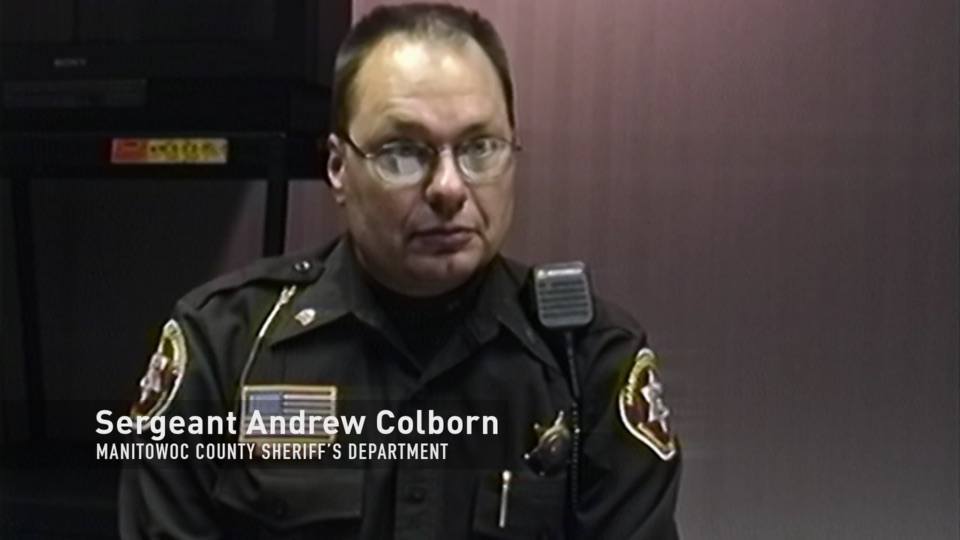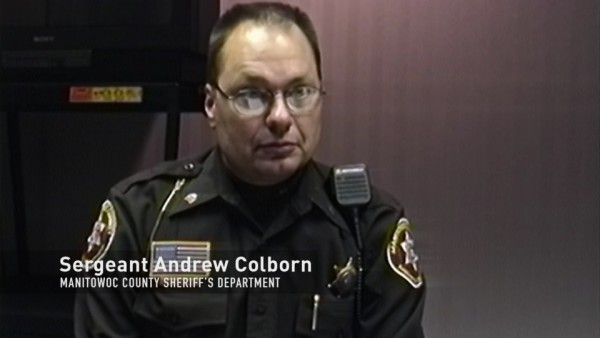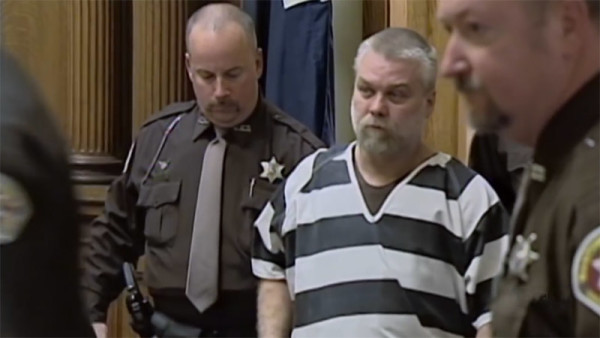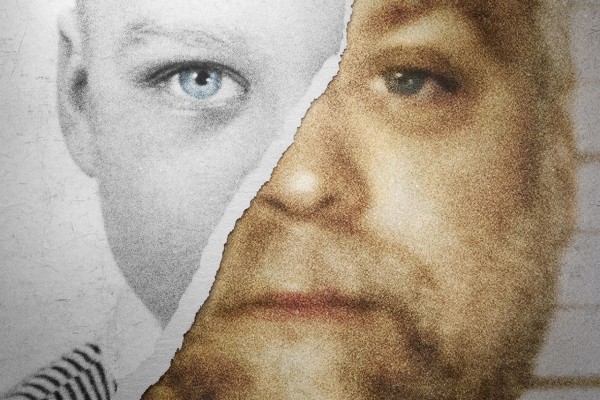
 Making a Murderer Episode 7
Making a Murderer Episode 7
With just four episodes left in the ten-part series, episode seven of “Making a Murderer” begins by focusing on the fact that the Manitowoc County Sheriff’s Department was not supposed to be a part of the investigation.
We know that they ignored this guideline as officers from surrounding counties were supposed to babysit any Manitowoc cops to make sure they were acting properly.
Why would the prosecuting attorney allow that when it would obviously be used by the defense when the trial began? My theory is that the powers that be had no one to answer to so they followed basic human behavior….doing what they wished because no one was stopping them.
The most comical witness yet hit the stand and was shown to be a typical meat head by the defense team. Deputy Daniel Kucharski tried to paint the perfect picture during his testimony. He does admit to being busy while he was with Lenk and Colborn in the bedroom search when the RAV4 key was found.
His “aliens” comment was mocked by Jerry Buting as the defense tried to show how unlikely it was that the key had been missed in prior searches of Steven Avery‘s bedroom.
We’re told the key must have fallen from a bookcase, but the deputy claims he didn’t hear it fall on the carpet. It seems impossible that the key fell under the slippers on the floor where the police claim to have found it.
Lenk hits the stand, and this guy is hard to crack, even when seemingly caught in a conflict. He refuses to admit that it was unfair to Avery that officers being sued by the suspect were searching his property for evidence that would send the man to back jail.
The most disgusting part of this episode is when Ken Kratz acts so indignant after Lenk’s character is called into question. He’s basically saying we have to trust the police because they are the police. This circular logic is so ridiculous, yet amazingly there are millions of people who go along with it.
Actions not words folks! Uniforms don’t make people more honest although that is the ideal the ones wearing the uniforms should strive toward
Our boy Sgt. Colborn tries to win a Golden Globes Award as he makes sure the jury knows he handled the bookcase “roughly,” to show the key falling out is plausible.
The defense brings up the call from the Beernsten case in which Colborn failed to make a report that could have freed Avery on evidence of another suspect admitting that he had committed a crime for which another guy (Avery) was doing time.
Kratz tries to make the call look routine along with the fact that no report was made by Colborn. That is blown apart by Buting who shows that the officer did, in fact, make a report about the call, eight years later when Avery was released from prison. Colborn has to admit that phone call was the only one he can remember in his career that involved a detective saying he was holding a suspect who was admitting to a crime for which another person was convicted.
I can’t see how a juror could ignore how this officer ignored an important tip at the time. Only a person who refuses to fathom a rogue cop would buy the story of the tip being unimportant.

But the fact that the logbook was not started immediately is the issue.
One more tidbit of doubt that should sway a thinking jury.
Once again the local press is subjected to the prosecution defending the Manitowoc officers as “good decent men.” The local press appears unwilling to really go after the cops harshly. I certainly didn’t read every article in their local paper, but I am sure they didn’t attack this case like TMZ or DeadSpin with no regard for pissing off the authorities.
Strang, when asked at a presser about physical evidence of a conspiracy, says, “You’re seeing the evidence of a conspiracy play out.” He notes he has seen federal conspiracy cases that were proven based on much less evidence that they have already put forth.
Buting tells the press that the cops think they are framing a guilty man, not an innocent one. I’m not so sure about that, and I don’t think that would work well in front of the jury.
We get back to the blood vial that the defense theorized the cops used to plant Avery’s blood in the RAV4 and on Halbach’s key.
I asked a family member that has worked for a lab such as the one mentioned in the film. She says they would use a needle to insert the blood into the vial initially. That explains the needle hole in the top that Buting says must have been made by someone pulling blood out. That doesn’t mean Lenk or another cop did not do what the defense believes. It’s still possible, and most likely, a person taking blood out of the vial would use the same hole like the one used to input the blood.
The testing done by the FBI to determine if the blood found in the RAV4 had EDTA in it was crucial. If the test showed this preservative, then it would show the blood was planted, if no EDTA then it would show the blood was dripped directly from Steven Avery.
The defense showed that the testing was unreliable, and the FBI had stopped using it except for this rushed case. The Bureau’s Chemistry Unit Chief Marc LeBeau was on the stand to show the results.
LeBeau shows just what the prosecution needs, that the blood found in the Toyota contained no EDTA so Avery must have had contact inside the car. This was not a shock as once again we see conviction as the goal here, not the truth.
The defense did a good job of discrediting the findings as they used their own chemist to refute some of the guess work that LeBeau put out there. The FBI’s expert stated that even though they only tested three swabs, which he was sure the untested other swabs would show no sign of EDTA.
Janine Arvizu, an analytical chemist, hit the stand for the defense and made it clear that the FBI’s test was not reliable. She also clowned the statement LeBeau made about swabs that were not tested, saying “I’m an analytical chemist and not in the business of guessing what’s in untested samples.” Boom!
Statements like these seem to be tremendous for the accused Steven Avery. That, however, hinges on an impartial jury and those jurors having the capacity of abstract thought.
Episode seven wraps up with a look toward the verdict. The family is told that no other charges matter if he found guilty of count one. First-degree intentional homicide would send Avery to prison forever.
We also see that Avery will not testify on his own behalf. It’s easy to criticize this decision. Most would feel if Avery has nothing to hide then he should tell his story. I would agree but we have already seen the tactics the prosecution has used, so I wouldn’t trust a not so sharp guy on the stand getting attacked by Ken Kratz.
This move may make Avery look guilty to some jurors, yet having him simply make a mistake on the stand would be even worse.
 Making A Murderer Updates:
Making A Murderer Updates:
Of course, Ken Kratz is running to every media outlet to say that the documentary filmmakers have left out crucial evidence. He can say all this with a straight face not realizing the irony of his own words. He’s now got the ear of The New York Times hoping that can sway viewers over to his side, but as he has quite the shady past himself, he should realize, there’s not much chance of his words being considered much more valuable than he considers the innocence of Steven Avery.
Here’s what he had to say to the gray lady:
Since Netflix released the documentary “Making a Murderer” in mid-December, its imprisoned central character has received a wave of support, including more than 275,000 signatures on a petition asking President Obama to pardon him.
The 10-part series, by the filmmakers Laura Ricciardi and Moira Demos, depicts a true-crime saga that seethes with troubling questions over whether Steven Avery, a Wisconsin man convicted of the 2005 murder of a young woman, was framed by law enforcement officials.
But the prosecutor in the case, Ken Kratz, said viewers convinced of Mr. Avery’s innocence did not get to see important evidence that led a jury to convict him.
The series “really presents misinformation,” Mr. Kratz said in an interview on Monday.
He portrayed the program as a tool of Mr. Avery’s defense and accused the filmmakers of intentionally withholding facts that would lead viewers to see his gMuch less than a dispassionate portrayal of the case, the film is a result of the filmmakers’ “agenda” to portray Mr. Avery as innocent and stoke public outrage, Mr. Kratz said. “That is absolutely what they wanted to happen,” he added.
Ms. Ricciardi, Ms. Demos and one of Mr. Avery’s lawyers, Dean Strang, disputed Mr. Kratz’s remarks in interviews on Monday, arguing that the documentary couldn’t have included every facet of the case.
“Our opinion is that we included the state’s most compelling evidence,” Ms. Ricciardi said.
Mr. Strang echoed that view. “No one’s going to watch a 600-hour movie of gavel-to-gavel, unedited coverage of a trial,” he said.
“Making a Murderer” has given rise to an army of armchair detectives since its release the week before Christmas. Ten years in the making, the film tracks the legal troubles of Mr. Avery, the part owner of an auto salvage yard who, in 2003, was freed after 18 years in prison when DNA evidence cleared him in a 1985 sexual assault.
He later sued Manitowoc County, Wis., officials for $36 million. Then in 2005, shortly after several county officials were deposed over their handling of evidence in the case, Mr. Avery was accused once again. This time, he was charged with the murder of Teresa Halbach, a 25-year-old photographer who had visited his property to take pictures of a vehicle for Auto Trader magazine.
In 2007, Mr. Avery was convicted and sentenced to life in prison without parole. The same year, his 16-year-old nephew, Brendan Dassey, was convicted of participating in the murder as well as the sexual assault of Ms. Halbach. He is serving life with the possibility of early release in 2048.
A second petition at Whitehouse.gov with more than 70,000 signatures calls on Mr. Obama to pardon Mr. Dassey along with Mr. Avery. (The president only has the power to grant pardons for crimes prosecuted under federal, not state, law.)
The documentary impugns the criminal justice system’s pursuit of Mr. Avery and Mr. Dassey at nearly every turn, pointing the finger at investigators, prosecutors and a defense lawyer who was assigned to Mr. Dassey.
The most explosive contention comes from Mr. Avery’s defense team — that law enforcement officials planted evidence to frame him.
On Monday, Mr. Kratz called the scenario “nonsense,” and he said the jury in Mr. Avery’s trial considered evidence either left out or glossed over by the filmmakers.
That evidence included DNA from Mr. Avery’s sweat found on a latch under the hood of Ms. Halbach’s Toyota RAV4, a discovery made by investigators after they were led there by Mr. Dassey, Mr. Kratz said.
Mr. Avery’s blood was found inside Ms. Halbach’s vehicle, and the documentary explains the defense theory that it could have been planted there by officers who had access to a vial of his blood. Sweat, however, never came up.
“How do you get Avery’s sweat underneath a hood latch of a vehicle?” Mr. Kratz said. “That is completely inconsistent with any kind of planting.”
Mr. Kratz also said a bullet with Ms. Halbach’s DNA on it found in Mr. Avery’s garage was matched to a rifle that hung over Mr. Avery’s bed. The gun was confiscated when officers searched his trailer on Nov. 5, 2005, and the bullet was found in the garage in March 2006, Mr. Kratz said.
“If they planted it, how did they get a bullet that was shot from Avery’s gun before Nov. 5?” he said.
Mr. Strang, the defense attorney, said on Monday that the DNA found under the hood was never identified as sweat and that its presence did not require that Mr. Avery touched the car. And bullet fragments were all over the property, where the family often shot guns. That Ms. Halbach’s DNA was on the bullet “really didn’t move the needle one way or another,” Mr. Strang said.
Mr. Kratz acknowledged some missteps in the handling of Mr. Avery’s case, saying he wished the Manitowoc County sheriff’s deputies had been less involved in the investigation. “That made the case a little more challenging for me, because I certainly took every step to keep those people out of it,” he said.
He also expressed regret about a news conference he held when Mr. Dassey was charged in early 2006. The documentary portrayed the prosecutor’s lurid description of the rape and murder of Ms. Halbach in front of a bank of news microphones as polluting the potential juror pool.
Mr. Kratz thought, at the time, that it was important to refute accusations of wrongdoing by law enforcement officers, he said.
“In retrospect, I wish I would have simply released the complaint and allowed the media to cover that however they wanted to,” he said.
Ms. Ricciardi and Ms. Demos on Monday disputed the idea that they were working on Mr. Avery’s behalf. They were inspired to create the documentary after reading about the new charges against him on the front page of The New York Times in 2005, Ms. Ricciardi said.
“He was uniquely positioned to take us and viewers from one extreme of the American criminal justice system to the other,” she said.
Ms. Ricciardi rejected the accusations of bias from Mr. Kratz, saying that his refusal to be interviewed for the documentary rendered them baseless. Mr. Kratz, who resigned as prosecutor in 2010, said he declined to participate because he did not believe the film would be impartial.
Neither the groundswell of outrage over the case nor the attacks that have been directed at him personally, have shaken Mr. Kratz’s certainty that justice was served.
“Steven Avery committed this murder and this mutilation, and Steven Avery is exactly where he needs to be,” he said. “And I don’t have any qualms about that, nor do I lose any sleep over that.”
It’s interesting that he’s forgotten that his own controversies that arose while in office are something that will be used against his integrity much like he used Steven Avery’s. If you haven’t learned what Kratz’s own scandal was, he was accused of sexting a young woman who had filed a domestic violence charge against her boyfriend. Kratz was prosecuting this, and two more women came forward with the same accusations of harassment and intimidation by the man who was supposed to be helping them.
Kratz resigned in 2010 after Governor Jim Doyle was pushing for him to step down. A federal lawsuit was filed which was settled out of court in 2013 and then Kenny boy admitted to abusing prescription drugs along with suffering from sexual addiction. Yup, that’s the man to believe.

Hundreds of thousands of people have signed online petitions to free convicted murderer Steven Avery, and now there may have been a small crack in the “Making a Murderer” case.
Speaking on TODAY Tuesday, filmmakers Laura Ricciardi and Moira Demos said a juror from Avery’s 2005 murder case in Wisconsin reached out to them amid the frenzy over their hit series to say they believed Avery was framed by law enforcement.
But the juror never spoke up because he or she feared what might happen, the filmmaking duo said.
“(The juror) told us that they believe Steven Avery was not proven guilty,” Ricciardi said. “They believe Steven was framed by law enforcement and that he deserves a new trial, and if he receives a new trial, in their opinion it should take place far away from Wisconsin.”
There was behind-the-scenes vote-trading going on during the trial, the juror told the filmmakers, and the verdicts on each count were “a compromise.”
“That was the actual word the juror used and went on to describe the jurors ultimately trading votes in the jury room and explicitly discussing, ‘If you vote guilty on this count, I will vote not guilty on this count,'” Ricciardi said.
“So that was a significant revelation.”
The juror also said he or she voted to convict but claimed the decision came under duress.
“They told us really that they were afraid that if they held out for a mistrial that it would be easy to identify which juror had done that and that they were fearful for their own safety,” Demos said.
The filmmakers said they have not been able to verify the claims because they have not spoken with any other jurors. If there was a new trial, though, the mystery juror would be willing to serve as a “source,” they said.
Avery, 53, initially served 18 years in prison for rape until being exonerated by DNA evidence. However, in 2005, two years after his release, he was convicted of murder in the death of Teresa Halbach and sentenced to life in prison.


